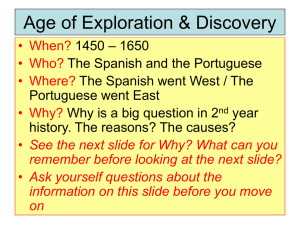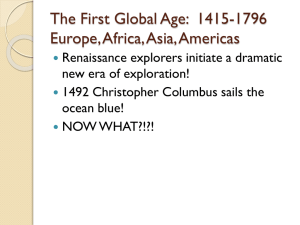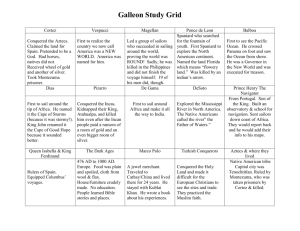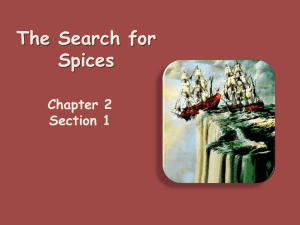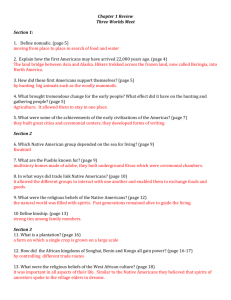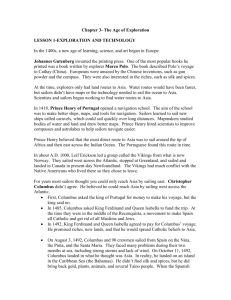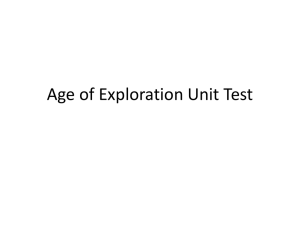Technology Allows Exploration
advertisement
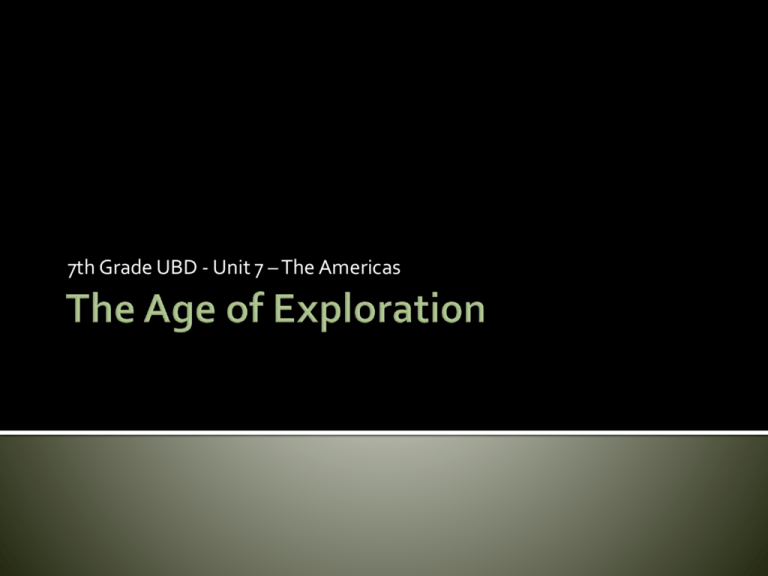
7th Grade UBD - Unit 7 – The Americas Technology Allows Exploration- Between 1100 CE and 1400 CE new technologies emerged which helped sailors sail farther from land. Christopher Columbus- An explorer, colonizer, and navigator who made four voyages across the Atlantic Ocean, leading to widespread awareness of the Americas. Ferdinand Magellan- Tried to circumnavigate the world. His crew proved once and for all that what Columbus had discovered was indeed a new world. Early sailors were limited by what they could see. If they traveled out into the open ocean away from land they would get lost. They used landmarks along the coast to help them navigate. The final invention that allowed sailors to travel further from home was that of the triangle-shaped sail. This new type of sail allowed ships to harness the power of the wind to travel in any direction. Between 1100 CE and 1400 CE new technologies emerged which helped sailors sail farther. During the Age of Exploration Europe had a population of about 60 million people. Europeans at this time had little contact with outsiders. Most Europeans did not venture beyond the safe and familiar boundaries of their isolated world. Those few who were ambitious enough to seek new experiences in strange places faced discouraging obstacles. Small slow ships took two months just to travel from one end of the Mediterranean Sea to the other. Travel over land, even more difficult and time-consuming. Early sailors were limited by what they could see. If they traveled out into the open ocean away from land they would get lost. Early sailors used landmarks along the coast to help them navigate. Between 1100 CE and 1400 CE new technologies emerged which helped early sailors. The astrolabe helped sailors measure objects in the sky such as stars, planets, the moon and sun. After measurements were taken, the use of star charts then helped sailors to determine their location. The compass was another invention that helped sailors to determine what direction they were traveling. Maps also began to improve. For centuries the maps used by travelers had been very inaccurate. By 1400s map makers began to use grid lines known as latitude and longitude to help travelers measure and determine where they were. Up until the 1400s ships had been equipped with square-shaped sails. These sails only allowed explorers to travel in the same direction that the wind was blowing. If the wind stopped blowing in the right direction, they had to either paddle or wait for the wind. The Portuguese developed a new type of ship called a Caravel. The Caravel had a center mounted rudder and a triangle-shaped sail that made it very fast and maneuverable. The triangle-shaped sail allowed ships to harness the power of the wind to travel in any direction, and not just in the direction that the wind was blowing. Reading Handout- Traders, Explorers, and Colonists Video- Modern Marvels- Super Ships Key Term Compass - An instrument whose magnetized metal needle aligns itself with the magnetic fields of the earth. This causes one end of the needle to point north. Key Term Navigate- To direct or manage a ship on its course. Key Term Astrolabe – A tool used by navigators in the 1400s and 1500s to determine a ship’s position by charting the position of the stars. Key Term Caravel– A small Portuguese ship that is very fast and maneuverable. Video- How Math Guides Ships Key Term Christopher Columbus-An Italian navigator who discovered the New World in the service of Spain. Explorer, colonizer, and navigator who made four voyages across the Atlantic Ocean, leading to widespread awareness of the Americas. His expeditions began the first enduring European exploration and colonization of the Americas. Tried to reach the East Indies by sailing west from Spain, with support from the Spanish monarchy looking for trade advantage. Called the inhabitants of the places he visited “ Indians,” never admitting that he had found a continent previously unknown. Thought that Asia was much closer to Europe than it was. Would become Governor of any lands discovered. Keep ten percent of all wealth discovered. Three ships: the Niña, the Pinta, and the Santa Maria. A crew of about 90 men and boys. Set sail from Spain on Aug 3, 1492. Landed in the Bahamas on Oct. 12, 1492. Columbus was certain that he had succeeded in reaching Asia, so he wrote a letter to King Ferdinand and Queen Isabella declaring his voyage a success. Ferdinand and Isabella were very excited when they heard Columbus’s news. They were even more pleased when he appeared before them with gold as well as six natives whom Columbus planned to teach Spanish and use as interpreters on later voyages. Isabella believed that Columbus should convert, or change the religious beliefs of the natives so they could also serve as missionaries on future voyages. Key Term Missionary - A person who teaches his or her religion to others who have different beliefs and attempts to convert them. Columbus began preparing almost immediately for a second voyage across the Atlantic Ocean, this one with a much larger fleet. Between 1493 and 1504, Columbus made three more trips to the Americas. On his second voyage he found that the men he had left had all been killed by the Indians. Apparently, as soon as Columbus left, the Spanish had begun to quarrel and fight among themselves. They had made no common effort to build a lasting community. Bands of Spanish thieves roved the countryside, plundering native villages. They forced the Indians to hunt for gold and took women as their prisoners. The Indians defend themselves and killed the Spanish intruders. Columbus never found the gold and jewels he had expected. Apart from his hunt for wealth, his mission was to convert the natives to Christianity. The idea that the Indians might have a right to determine their own way of life and to govern themselves never occurred to him. In 1500 Columbus was sent back to Spain and was removed as governor of the Indies. In the end, he retained only empty honors. Sick, disappointed, and ignored, he died in Spain in 1506. 1. Why did Christopher Columbus want to sail the Atlantic Ocean? 2. How did Europeans respond to news of Columbus’s first voyage? 3. Do you think Columbus’s voyages were a success or a failure? Explain your answer. Why did Christopher Columbus want to sail the Atlantic Ocean? 1. He wanted to sail across the Atlantic Ocean to find a sea route to Asia. Would become Governor of any lands discovered and would keep ten percent of all wealth discovered. How did Europeans respond to news of Columbus’s first 2. voyage? Ferdinand and Isabella were excited and pleased. Do you think Columbus’s voyages were a success or a failure? 3. Explain your answer. Student answers will vary. Video- Columbus Day Reading Activity- Eyewitness to History 18 The promise of wealth, knowledge, and adventure lured other explorers like Columbus to take to the seas. Like Columbus, they explored for foreign countries searching for a western water route to Asia Started his main voyage in 1519 leaving from Portugal. Attempted to become the first person to circumnavigate the world. In 1521 while in the Philippines, Magellan was killed while trying to circumnavigate the world. His crew still completed the voyage around the world. Key Term CircumnavigateTo go completely around the world. Key Term Ferdinand MagellanA Portuguese navigator in the service of Spain, attempted to circumnavigate the world. Video-Ballad of Magellan As a young man, Magellan fought as a soldier while Portugal seized different colonies in India and Africa. Magellan believed he could make it to the Spice Islands by finding a water route around South America. He convinced the King of Spain to support him by telling him that part of the Spice Islands were in Spanish territory. In 1519, he set sail from, Spain in an effort to sail around the world. After Magellan and his 260 men and five ships reached South America, they began looking for a way through the continent to the other side. As Magellan traveled through the Pacific Ocean, one of his ships became separated and was forced to return to Spain. Another ship crashed on a rocky island. By the time Magellan and his ships reached the Philippines in Asia, the sailors had spent 18 long months at sea. Then, during a battle there, Magellan and several crew members were killed. Only one boat and 18 crew members succeeded in sailing completely around, the world. Magellan’s crew was the first to circumnavigate the world. They proved once and for all that what Columbus had discovered was indeed a new world. They also discovered just how large the Earth really was. Reading Activity- Eyewitness to History 19 1. Where is the passage way known as the Strait of Magellan? 2. Imagine that you are a survivors of Magellan’s voyage. Write five questions that you will ask about the importance of their journey. Then write answers that you imagine the crew would give, using information found in the PowerPoint. Where is the passage way known as the Strait of Magellan? 1. It lies near the southern tip of South America. Imagine that you are a survivors of Magellan’s voyage. 2. Write five questions that you will ask about the importance of their journey. Then write answers that you imagine the crew would give, using information found in the PowerPoint. Student answers will vary. What has been the “muddiest” point so far in this lesson? That is, what topic remains the least clear to you? (4 minutes) Work with a neighbor and compare your muddiest point with theirs. Compare what things are the same and what things are different? (3 minutes)
